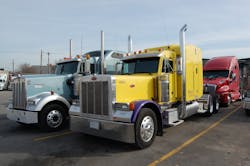ATA: tonnage slipped in February
The American Trucking Associations (ATA) said its for-hire truck tonnage index slipped 0.1% in February following a 2.9% increase in January, with the index down 2.8% on a year-over-year basis when compared to February 2016.
However, year-to-date when compared with the same two months in 2016, the index is only off 0.1%, noted Bob Costello, ATA’s chief economist, in a statement.
“February’s numbers, especially the year-over-year drop, might surprise some as several other economic indicators were positive in February,” he explained. “However, I’m not worried about the decline from February last year as it was really due to very difficult comparisons more than anything else: February 2016 was abnormally strong.”
For all of 2016, Costello noted that tonnage was up 2.5% and said signs “remain mostly positive” for truck tonnage going forward.
“Lower inventory levels, better manufacturing activity, solid housing starts, good consumer spending, as well as an increase in the oil rig count, are all drivers of freight volume,” he emphasized.
Jonathan Starks, chief operating officer at research firm FTR, noted tin a statement that he sees similar positive trends developing for trucking as a whole this year.
“It’s looking like 2017 will be a better year for the trucking industry,” he said. “This late recovery is consumer driven, which is relatively light on increasing freight demand, but we will see modest growth. If capacity doesn’t meet demand, then truckers will be able to raise prices. However, we don’t expect to see that impact until late 2017, or into 2018.”
Starks added that his firm’s Trucking Conditions Index (TCI) for January remained basically unchanged from December at 2.7, which Starks expects to be “the low point” for trucking conditions ahead of an expected bounce as 2017 progresses.
“More importantly, the industry is really beginning to face up to the costs and changes from ELD [electronic logging device] implementation,” he stressed. “We expect a productivity and capacity hit to the industry, though the effects will be felt differently, with early adopters ahead of the curve.”
One of the big issues Starks expects trucking companies to continue struggling with is the driver situation, with the number of new hires not keeping pace with overall demand for drivers.
“We are also closely tracking government policies and actions,” he added. “The main concern continues to be the possibility of trade wars which could have immediate and detrimental impacts on freight transportation.”
